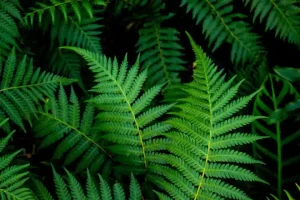Fractals are complex and eye-catching shapes that are composed of parts that appear to be a smaller version of the whole. If you look closely, you’ll see examples of these shapes everywhere in natural systems. How do fractals appear in nature?
Fractal shapes appear in nature as ferns, trees, snowflakes, lightning, plant shapes, river deltas, mountains, clouds, crystals, and in bodily systems like the circulatory and respiratory systems of animals. These examples are self-similar and often look alike when zooming in and out.
These examples are not an exhaustive set and fractal shapes appear commonly in nature. I’ll cover each of these cases in detail as well as what causes natural systems to favor fractal shapes. Soon you’ll see fractals everywhere around you!
Why Are Fractals So Common In Nature?
Table of Contents
- Why Are Fractals So Common In Nature?
- Examples of Fractals in Nature
- How Is A River A Fractal?
- Fractal Coastlines: How Long is the Coast?
- Fractals in Snowflakes
- Fractal Tree Shapes
- Lightning and Other Electrical Fractal Shapes
- Turbulence and Fractal Cloud Shapes
- Crystal Formations and Fractal Facets
- Fractal Ferns and Plants
- Fractal Systems: Respiratory, Nervous, and Circulatory
- Mountains and Fractal Landscapes
- Fractals and the Fibonacci Sequence in Nature
- Natural Fractal Finale
- References
So why do plants and other natural shapes follow one of these patterns? The secret comes from DNA. All living organisms originally grow from a small number of cells. These cells grow, copy their DNA, and divide. The instructions for the cell are contained in the DNA and each carries out its instructions during its lifespan. By encoding simple, self-similar, and repeating shapes, the instructions for a complex organ like a circulatory system for delivering blood can be stored in a compact set of instructions.
A second reason natural shapes follow fractal patterns is that they allow for the efficient delivery and transportation of nutrients and resources. Since the shape originates in a large central instance like an artery and flows outward into progressively smaller versions of itself, the nutrients and resources are efficiently spread and delivered to where they are needed.
Some examples of this efficient delivery system include blood vessels, lung airways, root systems delivering water, fern leaves maximizing sun exposure, and river systems like the Nile which flood and deliver sediment to the surrounding farming communities.
Examples of Fractals in Nature
Fractal shapes are composed from just a few simple rules. For example, a rule might be: ‘draw a line that forks into two lines’. On each of the forks, that rule can be repeated forever. As the forks get smaller and smaller, the whole shape might resemble a natural tree.
How Is A River A Fractal?
Rivers are often fractal in their shapes on both ends of the river. First, the river is formed from many lakes, streams, and estuaries emptying into one central river that contains water from many source locations. Eventually, the river often empties into an ocean and forms a river delta which also follows a fractal pattern. This is why so many rivers resemble blood vessels and form similar shapes.
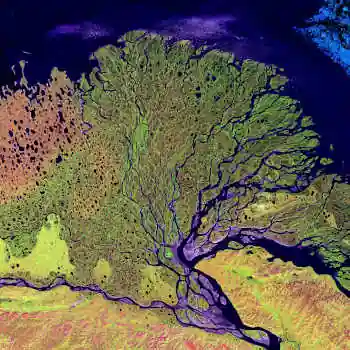
The rivers also distort and deform the landscape that they travel over through erosion and flooding. Often, even after a river has dried up or a flood basin has emptied the distinctive fractal pattern of the river is visible in the landscape. Much of the Columbia River basin in eastern Washington and the Willamette Valley in western Oregon in the United States are the result of glacial floods 15,000 years ago. The river patterns are still visible today!
Fractal Coastlines: How Long is the Coast?
One of the most iconic examples of natural fractals comes from coastlines. In his famous demonstration, Benoit Mandelbrot asked, ‘How Long is the Coast of Britain?’. He pointed out that with fractal shapes, the length can be infinitely long.
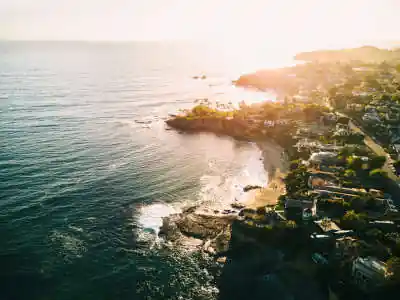
By using smaller and smaller rulers, the person measuring gets a more accurate – and ever increasing measurement. At the high level you might measure miles of coastline in a straight line, but as the ruler is smaller and smaller each rocky outcropping and nook adds length.
Fractals in Snowflakes
Everyone learns as kid (at least in the areas where snow is common) that each snowflake has a unique shape, size, and pattern. This was first photographed by Wilson Bentley and is captured in the iconic children’s book Snowflake Bentley.
Since the water droplets freeze in a natural crystal pattern, this shape is often fractal and self-similar containing vast variation and intricate detail. The snowflake pattern repeats itself at a smaller scale and the crystal can hold its shape efficiently.
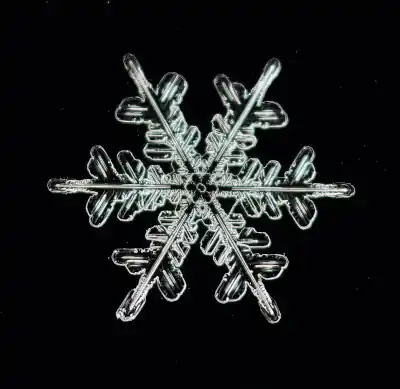
The shape begins in a central location where the water freezes and as it expands outward the fractal pattern forms. For artificial patterns, this idea is captured by the Koch Snowflake. You can learn to draw the Koch Snowflake in my complete guide on fractal drawings!
Fractal Tree Shapes
The shape of a tree is essentially one big fractal. Starting at the trunk, the tree branches into smaller and smaller branches that grow twigs and offshoots of their own. Each branch also has its own branches that twist and turn into many limbs.
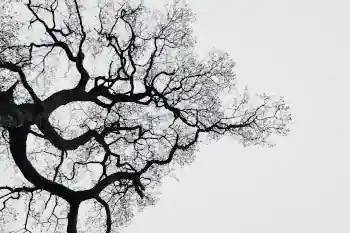
This shape efficiently distributes water to the leaves and maximizes the area that the leaves can use to harness sunlight. As the tree grows bigger and bigger, the fractal shape repeats and allows the tree to grow to many sizes using the same natural design.
Lightning and Other Electrical Fractal Shapes
Lightning and electricity often form fractal shapes and for the same reasons as rivers. As water flows from a high spot to a low point, it meets resistance in the landscape. It follows the path of least resistance as it flows and the river forms self-similar branches.
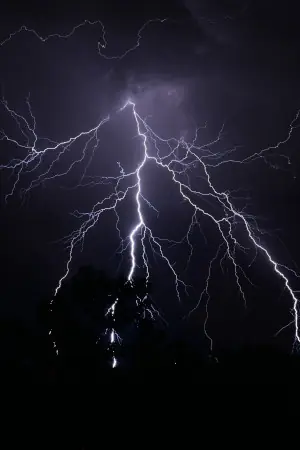
As lightning travels from a place of high potential to one of low potential, it also follows the path of least resistance and forms branching patterns. The current causes spreading or branching into tree-like formations as electrons travel through the material over time.
A Lichtenberg figure is an electric discharge pattern in branching form which appears on the surface or internally in insulating materials. Often, the electrical discharge in someone who is struck by lightning can leave a scar or tattoo called a Lichtenberg figure, which creates a fractal pattern. This pattern is also visible in Fractal Wood Burning (or Lichtenberg Burning) and electricity is used to burn a beautiful pattern in a wooden item.
Want to know more about this exciting area of artwork that uses fractal patterns for woodworking? Check out my post about the invention of Fractal wood burning!
Turbulence and Fractal Cloud Shapes
In the atmosphere, the heating and cooling of different areas by the sun causes there to be a heat differential between different parts of the atmosphere. As the differential returns to equilibrium, air flows from the hot spots to the cool, causing wind and other air currents.
These turbulent currents are often chaotic and unpredictable. The air also contains varying levels of moisture, and condensation happens spontaneously forming clouds. Just like other natural systems, clouds can appear self-similar where one small area of the cloud resembles the larger cloud. This self-similarity sometimes gives cloud systems a fractal shape.
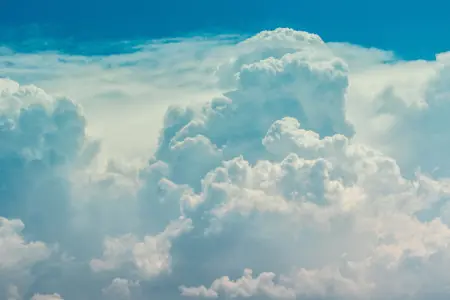
Clouds have distinctive shapes due to their fractal nature. In a 1985 paper, Shaun Lovejoy and Benoit Mandelbrot showed that the fractal dimension of clouds could be measured by recording the size of clouds at different scales. [1]
With the aid of satellite images, Lovejoy observed geographical regions of sizes ranging from 1 km to 3000 km. Areas with cloud cover differ from clear regions. These areas were mapped and observed to find out if cloud shapes are fractals. Between 1 and 1000 km, the fractal dimension of 1.35 was obtained.
Crystal Formations and Fractal Facets
Crystals formed from minerals in the Earth are created under intense pressure and produce beautiful and often valuable shapes and patterns. Just like the formation of the ice crystal in a snowflake, mineral crystals are formed based on imperfections and form unique shapes.
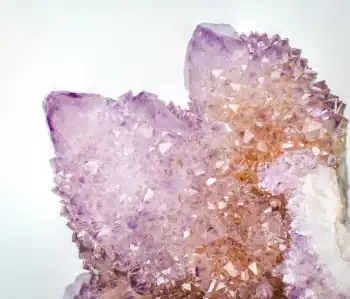
The crystal lattice (like in a diamond) is formed from a perfect grid of atoms which are locked into place by intense pressure. When there is an imperfection in the lattice, there is a resistance to the material just like water splitting in a river. The crystal pattern splits into two ‘branches’ and forms smaller crystals that are self-similar to the whole.
Fractal Ferns and Plants
Ferns are the iconic example of natural fractals. The self-similar branching can be easily seen in a clean and repeating pattern that expresses itself at different sizes and scales. The same can be seen in other plants like broccoli, cauliflower, pineapples, and cabbages.
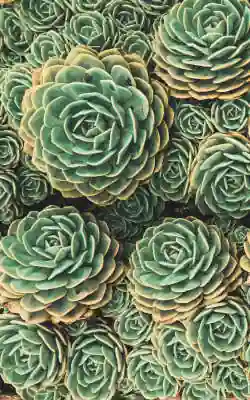
Just like with trees and other natural systems, the fractal shape allows for the efficient delivery and distribution of nutrients. The shape allows the plant to operate at different scales and maximizes the surface area that the leaves can utilize to harvest and process sunlight. In addition, it allows the plant to grow from simple instructions.
Fractal Systems: Respiratory, Nervous, and Circulatory
In the bodies of animals many complex organ systems are shaped like fractals. Three common examples include the respiratory, nervous, and circulatory systems. The systems all contain a central trunk like a tree – arteries, the spine, and the wind pipe before branching into smaller and self similar components. These components include blood vessels, major nerves, and the various branches of the lungs.
These systems form fractal shapes for similar reasons – just like with plants the shapes allow for the efficient distribution of resources and nutrients while allowing the system to operate on many different scales and sizes.
Mountains and Fractal Landscapes
Mountains and landscapes often form self-similar and fractal patterns. This is due to the fluids like water and wind causing erosion of the softer and lighter materials while the harder rocks and minerals of the mountain remain. The mountain range can also exhibit a fractal pattern on the larger scale as the smaller hills and outcroppings resemble the large peaks.

Mandelbrot studied fractal landscapes in his definitive work The Fractal Geometry of Nature. In the first instances where computer algorithms were used to generate realistic looking landscapes, fractal algorithms were utilized. You can read all about the development in my guide to Mandelbrot’s complete works!
Fractals and the Fibonacci Sequence in Nature
Plants that exhibit fractal patterns often also contain the Fibonacci sequence in the patterns of their leaves or flowers.
In 1202, the great Italian Mathematician Fibonacci aka Leonardo Bonacci or Leonardo of Pisa, popularized the Indo–Arabic numeral system in the west through his book Liber Abaci (Book of Calculation). The book introduced Europe to the idea of the sequence of Fibonacci numbers. The Fibonacci sequence contains a series of numbers in which each number is the sum of the two numbers preceding it. The Fibonacci series includes: 0, 1, 1, 2, 3, 5, 8, 13, 21, 34, and so on forever.
The Fibonacci sequence plays a fundamental role in phyllotaxis, a study of the arrangement of seeds, leaves, branches, flowers, and fruits of plants, aiming to identify the existence of regular recursive patterns and recurrent structures and forms. This self-similar and repeating recursive pattern produces the fractal shape.
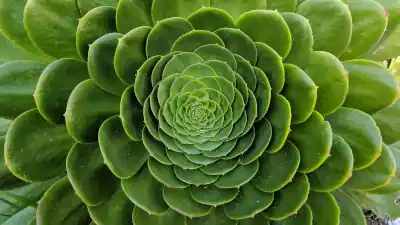
Sir D’Arcy Wentworth Thompson was a Scottish biologist and mathematician who observed that plants have a curious preference for certain numbers and spiral geometries, which are also closely related. Fibonacci series can be found in spirals formed by individual flowers in composite clusters of little flowers that seem like one big flower but are multiple smaller flowers clustered together called inflorescences. Examples include daisies, cauliflowers, broccoli, and sunflowers. In sunflowers, we can see individual flowers arranged along the curved lines, which rotate clockwise and anticlockwise.
Johannes Kepler, a 17th Century mathematician, German astronomer, natural philosopher, astrologer, and writer on music, noted that in many trees, leaves are aligned in a pattern that includes two Fibonacci series of numbers. Beginning from any leaf, after one, two, three, or five turns of the spiral, there will always be a leaf aligned with first and, based on the species, it will be second, third, fifth, eighth, or the thirteenth leaf. [2]
An example can be seen in several petals of flowers. Most have 3 petals like Lilies and Irises, 5 like Parnassia, Roses, or 8 like Cosmea. Daisies have 13, Chicory have 21, and some species of Asteraceae have 34, 55, or 89 petals. These numbers are all part of Fibonacci’s sequence.
Natural Fractal Finale
In natural systems it is clear that fractals form a foundation and critical function to a wide variety of phenomena, plant species, and animals. Hopefully you now have a greater appreciation of all the fractal patterns that surround us in our day-to-day lives. Nature leverages these patterns for a large number of different uses and applications.
References
- Lovejoy, Shaun, and Benoit B. Mandelbrot. “Fractal properties of rain, and a fractal model.” Tellus A 37.3 (1985): 209-232. https://onlinelibrary.wiley.com/doi/pdf/10.1111/j.1600-0870.1985.tb00423.x
- Mamombe, Lovemore. “On the analysis of the Fibonacci numbers: Critique to Kepler.” International Journal of Mathematics Trends and Technology 29.2 (2016): 62-9. http://www.ijmttjournal.org/2016/Volume-29/number-2/IJMTT-V29P511.pdf
